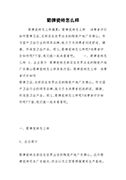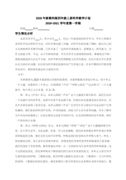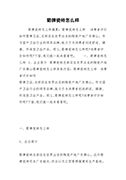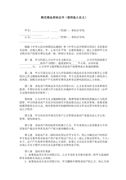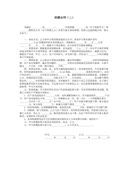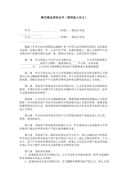《Water》教学设计(精选2篇)五年级英语教案
《Water》教学设计(精选2篇)
《Water》教学设计 篇1
module 3 the natural elementsunit 3 sea water and rain waterteaching plantopic:牛津7a module3 unit 3 sea water and rain waterperiod: the first period.school: ye xie middle school.name: zhang xiaoxia(张晓霞)teaching aims: 1. knowledgable objectives:(1) to learn and use some new words about oceans.(2) to learn how to ask ‘how’ and ‘wh-’ questions to find out various kinds of specific information.(3) to have a general idea of the text.2. ability objectives:(1) to improve students’ listening and speaking ability.(2) to have the awareness of competition.3. emotional objectives:(1) to know about the wonderful world under the water.(2) to educate students that people should protect oceans and the lives in water.teaching difficulties: one of …, by doing sth.stepstimeactivitiespurposeteacher’sstudents’warming-up2’
show the english poem: water around us (ppt.)
read this poem together.
introduce the topic of this class.pre-taskpreparation6’
1.show a picture of the earth (ppt). 2.ask some questions about water on the earth: 1) how many kinds of water are there on the earth ? 2) what kind of water do people drink? why? 3) can people live without water? 4) how much water do we have on the earth? 3. give some key words: how many …? how much…? what…?
1.answer: what are the white parts/brown parts /blue parts? 2. listen to their teacher and answer the questions. 3. work in pairs with the key words.
1.introduce:quarter.
2.improve students’ listening and speaking abilities.
3.to make students learn how to ask ‘how’ and ‘wh’ questions.
while-task activities
2’
1.ask questions: 1) what lives on land? 2) what lives under the water? 2. tell students with a slide: it is a wonderful world under the water.
answer teacher’s questions.
arouse students’ interest in learning this text.
7’
1.show some pictures of sea animals and plants.(ppt.)
2.give the dialogue pattern: have you ever seen…? yes, i have./no, i haven’t.(not yet.)
1.learn some new words.
2.work in pairs and make a dialogue.
1. to make students learn and speak out the names of sea animals and plants easily. 2. to show the paragraph 3 of this text.
6’
1.introduce three kinds of main sea animals: whales, dolphins and sharks. 2. explain the difficulty: one of….
1. read the paragraph 2 of the text.
2. make sentences with the phrase: one of…
introduce teaching difficulty: one of…
5’
1. give some questions: 1) what can the oceans give us? 2)how can people get drinking water from sea water? 3) are the oceans important to all animals? why? (ppt.)
1. first read teacher’s questions then read the paragraph4 and answer the questions.
1. improve students’ reading ability. 2. to educate students to love all kind of the ocean lives. 3. introdue: by doing….
post-task activity
12’
introduce the rules of the class competition: the oceans.
answer the questions and discuss the topics in groups.
1.to make students have the awareness of competition. 2. to educate students to protect oceans and the lives in water.homework:recite the new words of this text.read the text at least three times.students’ activitycompetition about oceansi. ask students to get more information from computer before class.ii. divide the whole class into five groups.iii.give them ten questions. questions: how much of the earth is water?how many oceans are there in the world?what are they?which is the largest ocean of the four ?which is the smallest ? what is the largest animal, both on land and in the oceans?name two intelligent animals on the earth.name three beautiful things in the oceans.what can we get from the oceans?how can people get drinking water from the oceans?topics :how can we protect the earth?how can we protect the oceans?how can we save water?the importance of the oceans.the importance of sea animals and plants.sea water and rain water 教学设计说明本教案是7a m3the natural elementsu3sea water and rain water 的第一课时. 在学习本课之前我们已经学习了其他两种自然元素火和风,所以在对两者稍加复习的基础上很自然地引出我们今天要学习的第三种自然元素——水。我把本课时分为四个部分。在warming up中用以前学过的一首诗歌 water around us 来让学生对水有一个整体的复习。在pre-task preparation中用幻灯片来让学生了解水在地球上的分布。地球上有三种颜色分布:what are the white parts, brown parts and blue parts?(这部分也是对以前所学知识的复习. 地球上有很多的水,讨论水的种类,人们的饮用水,接着讨论水和陆地在地球上的比例,引出 quarter. 在while-task中,通过问问题:what lives on land? what lives under water? do you want to know about the world under the water? 来先涉及到文章的第三自然段。这一部分主要通过幻灯片让学生熟悉一些海洋生物的名称并就此操练have you ever seen…? 让学生热爱各种海洋生物,之后就学生们最感兴趣的三种海洋生物whales , dolphins and sharks 来讲解本节课的重点one of…. 本课的最后一段主要讲到海洋和人类的关系,这部分让学生带着问题去阅读,然后再回答问题。在post-task 中,我设计了一个关于海洋的知识竞赛,以培养学生的竞争和保护海洋环境的意识并使学生对本课知识有运用和拓展。
《Water》教学设计 篇2
教学目标:1、帮助学生了解look and learn中的词组。
2、通过listen and say的情景对话,让学生开展听录音朗读、问答等活动,帮助学生掌握核心句型。
读写说安排:读:读懂本单元的核心词汇,了解怎样询问和介绍水的用途。
写:正确书写本单元的核心句型:we use water to wash our hands.
说:用how do we use water?询问水的用途;
用we use water to简单介绍水的用途。
教学重难点:词汇:use, clothes, farmer, useful, grow crops, put out fires.
句型:we use water to wash our hands.
stepi : pre-task preparations
1、 利用谜语引出主题water。教师说谜语,让学生猜教师描述的是什么。
it has no color
it is everywhere around us
it is in the river
it is in the sea
we use it to wash our hands
we are thirsty, we can drink it
what is it?
stepii: presentation
1、 提问where does water come from?并出示一些跟水有关的图片,如水龙头、井、湖、海、河流等,与学生讨论。
it comes from the sea.
it comes from the tap.
it comes from the rain.
it comes from the lake.
2、 与学生讨论水的用途,导入核心句型及单词use和useful。
t: water is everywhere around us. water is very important. it is very useful. (write useful water on the blackboard)we use water to do a lot of things, we use water to wash our hands.
s: use, u-s-e, we use water to wash our hands.
t: water is very useful. u-s-e-f-u-l, useful.
s: water is very useful. u-s-e-f-u-l, useful.
3、 出示look and learn的图片,并提问学生水的用途。
t:(show the picture for put out fires)look at this picture. the firemen is using water to put out fires.
s: put out fires.
t: what do farmers use water for?(show the picture for grow crops)
s: they use water to grow crops.
4、 学生结对讨论how do we use water?将学生的答案出示在黑板上。
5、 播放课文listen and say的录音,学生先跟读,然后分角色朗读课文,并完成课本75页的练习。
complete the sentences.
1 water comes from the sea,
the rain and the tap .
2 we use water to wash our hands,
wash vegetables, wash clothes,
grow crops, and put out fires.
6、 板书
wash hands.
wash clothes.
we use water to cook food.
wash vegetables
put out fires.
grow crops.


